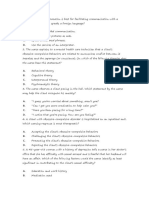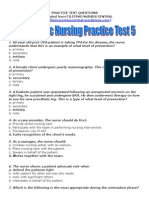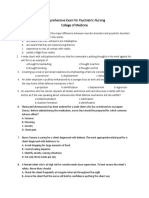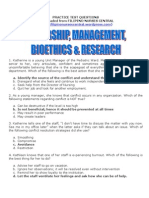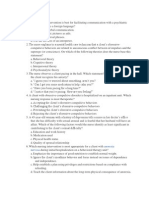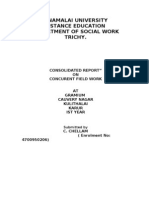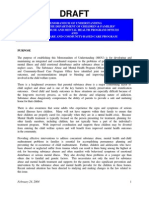Mental 1
Mental 1
Uploaded by
Gizelle GalapinCopyright:
Available Formats
Mental 1
Mental 1
Uploaded by
Gizelle GalapinCopyright
Available Formats
Share this document
Did you find this document useful?
Is this content inappropriate?
Copyright:
Available Formats
Mental 1
Mental 1
Uploaded by
Gizelle GalapinCopyright:
Available Formats
MENTAL 1 1.
When a nurse establishes a therapeutic relationship with a client, which of the following is the primary focus of the client s care? a. The medical Diagnosis c. The nursing diagnosis b. The client s needs and problems d. The client s social interaction 2. Which of the following is the overall purpose of therapeutic communication? a. To analyze client s problem c. To facilitate a helping relationship b. To elicit cooperation d. To provide emotional support 3. Which of the following communication technique is MOST effective in dealing with covert communication? a. Listening c. Clarification b. Evaluation d. Exploring 4. Which of the following is MOST important in fostering a positive relationship? a. The nurse recognizes that some point patient regress when confronted with illness b. The nurse functions as a positive role model to encourage health oriented patient behavior c. Needs to understand that patients may test her before he can accept and trust her d. The nurse must fully share the patient s feelings before she can develop her goal for her nursing care 5. Which of the following levels of anxiety is BEST for client s learning? a. Moderate c. Severe b. Mild d. No anxiety Situation: Paul, 16 years old was committed to a mental health facility with diagnosis of personality disorder. He has a history of promiscuity and running away. He tells the staff I can t stand this place, I want to go away. 6. How would the nurse deal effectively with Paul s threat to run away? a. Tell him to stay in her room b. Lock him in her room c. Tell him firmly that if he does not control herself, the staff will help him control herself d. Ignore the threat 7. The early experiences of Paul may indicate a history of: a. Severe parental rejection c. Severe temper Tantrums b. Failure in interpersonal relationship d. Failure to identify positively with a father 8. How would you describe parental rejection? a. Failure to identify positively with a father c. Lack of recognition as a person b. Lack of parental love and discipline d. Lack of capacity to trust other 9. In dealing with manipulative behavior, the nurse should convey an attitude of: a. Active friendliness c. Love and understanding b. Permissiveness d. Consistency Situation: Mark was brought to the National Center for Mental Health for substance abuse. 10. During rounds, the nurse reported to the physician that the patient is intoxicated with stimulants. Which of the following behaviors would the nurse report that indicates stimulant intoxification?
11.
12.
13.
14.
15.
a. Slurred speech, unsteady gait, impaired concentration b. Hyperactivity, talkativeness, euphoria c. Relaxed inhibitions, increased appetite, distorted perceptions d. Depersonalization, dilated pupils, visual hallucinations Which of the following statements would indicate the teaching about Naltrexone (Revia) had been effective? a. I ll get sick if I use heroine on this medication. b. This medication will block the effects of any opioid substance I take. c. If I use opioid while taking naltrexone, I ll become extremely ill. d. Using naltrexone may make me dizzy. Clonidine (Catapres) is prescribed for symptoms of opioid withdrawal. Which of the following nursing assessments is essential before giving a dose of this medication? a. Assessing the client s blood pressure b. Determining when the client last use an opiate c. Monitoring the client for tremors d. Completing a thorough physical assessment The nurse has provided an in-service program on impaired professionals. She knows that teaching has been effective when staff identify the following as the greatest risk for substance abuse among professionals: a. Most nurses are codependent in their personal and professional relationships b. Most nurses come from dysfunctional families and are risk for developing addiction c. Most nurses are exposed to various substance and believe they are not risk to develop the disease d. Most nurses have preconceived ideas about what kind of people become addicted The client tells the nurse that she takes a drink every morning to calm her nerves and stops her tremors. The nurse realizes the client is at risk for: a. An anxiety disorder c. Physical Dependence b. A neurological disorder d. Psychological Addiction The client admitted because of alcohol abuse asked for assurance that leather restraints would not be used under any circumstances during alcohol withdrawal. The nurse promised that no restraints would be used. During alcohol withdrawal, the client was very agitated, delirious and combative. Although restraints were indicated tp preserve the client s safety, the nurse opposed using them because of the promise made. This action made by the nurse was: a. Appropriate because of the nurse promise b. Inappropriate because the promise was not safe c. A violation of the Philippine Nurse Association Code of Ethics for Nurses d. A violation of the Philippine Nurse Association Nursing Standards
Situation: A nurse must be aware of the latest issues on Child Abuse and Family Violence. 16. When planning the care for a client who is abused, which of the following measures would be most important to include? a. Being compassionate and empathetic b. Teaching the client about abuse and the cycle of violence c. Explaining to the client his or her personal legal rights d. Helping the client develop a safety plan
17. Nurse A observes Nurse C telling the patient who is a victim of a child abuse that if he will not take the prescribed oral medications, dessert will be withheld. Nurse A should report the behavior of the staff member as: a. Assault c. Malpractice b. Battery d. Negligence 18. During the session with the nurse, a client who is being abused states, I don t know what to do anymore. He doesn t want me to go anywhere while he s at work, not even to visit my friends. Which of the following nursing diagnoses would the nurse formulate in respect to this information? a. Risk for violence related to abusive husband, as evidenced by victim s statement of being battered b. Low Self- Esteem related to victimization, as evidenced by not being able to leave the house c. Powerlessness related to abusive husband, as evidenced by inability to make decisions d. Ineffective coping related to victimization, as evidenced by crying Situation: Dementing illness and changes in the brain 19. When developing the plan of care for a client with Alzheimer s disease who is experiencing moderate impainment, which of the following types of care would the nurse expect to include? a. Considerable assistance with activities of daily living b. Managing complex medication schedule c. Constant supervision and total care d. Supervision of risky activities, such as shaving 20. When assessing a client with dementia, which of the following behaviors would the nurse document in the chart as a manifestation of disinhibition? a. Wandering and getting lost c. Decreased interest in bathing and hygiene b. Auditory and/or visual hallucinations d. Inappropriate language and sexual behaviors 21. The brains of persons with Alzheimer s disease are characterized by the presence of: a. Fatty deposits c. Calcium deposists b. Senile plaques and neurofibrillary tangles d. Lack of gray matter 22. An older adult client, Male 82 years old, receives a gift of boxed chocolate candy. The client has dementia and does not understand that the candy is his and what it is. The nurse should: a. Tell the client the candy is his and offer a piece b. Offer the candy to the other clients c. Send the candy home with the client s family d. Throw the candy away, since the client is unable to eat it. Situation: A 23-year-old man was voluntarily admitted to the inpatient unit with a diagnosis of paranoid schizophrenia. 23. As the nurse approaches the client, he says, If you come any closer, I ll die. The nurse should document in the chart that the patient is having a: a. Hallucination c. Illusion b. Delusion d. Idea of reference 24. The family of a client with schizophrenia asks the nurse what the brain imaging study ordered for the client is most likely to find. The most appropriate response by the nurse is: a. It would most likely find an absent frontal cortex.
b. It would most likely find abnormal auditory and optical nerves. c. It would most likely find over activity in the center of creativity. d. It would most likely find enlarged lateral and third ventricles. 25. When communicating with a personal client, the main principle is to: a. Use logic and be persistent c. Express doubt and do not argue b. Provide an anxiety-free environment d. Encourage ventilation of anger 26. The client tells his primary nurse that he s scheduled to meet the president of the Philippines a special time, making it impossible for the client to leave his room for dinner. Which of the following responses by the nurse is most appropriate? a. It s meal time. Let s go so you can eat. b. The President of the Philippines told me to take you to dinner. c. Your physician expects you to follow the unit s schedule. d. People who don t eat on this unit aren t being cooperative. 27. A schizophrenic patient who began taking haloperidol (Haloperidol) 1 week ago now exhibits jerking movements of the neck and mouth. During rounds, the nurse should report this to the doctor because the nurse knows that these are signs of: a. Dystonia c. Akathisia b. Psychosis d. Parkinsonism Situation: Nico, 27 yrs. old, is admitted for treatment of a major depression. 28. He is withdrawn, appears disheveled, and states, No one could ever love me. The nurse can expect the client to be placed on a. Antiparkinsonism medication c. A low-salt diet b. Suicide precautions d. Phototherapy 29. Which of the following behaviors indicates to the nurse that a client s major depression is improving? The client: a. Displays a blunted effect c. States one good thing about himself b. Has lost an additional 2 pounds d. Sleeps about 16 hours per day 30. Nico is scheduled for electroconvulsive therapy (ECT) tomorrow. The nurse would plan for which of the following activities? a. Force fluids 6 to 8 hours before treatment b. Administer atropine sulfate during pretreatment care c. Encourage the client s spouse to accompany him d. Reorient the client frequently during posttreatment care 31. Nico is recovering from a severe depression. Which of the following behaviors alerts the nurse to a risk for suicide? a. The client sleeps most of the day c. The client loses 5 pounds b. The client has a plan to kill himself d. The client does not attend unit activities 32. Nico has been depressed severely depressed for 2 weeks. He had mentioned ending it all prior to admission. Which of the following questions should the nurse ask during the prescreen assessment? a. How long have you thought about harming yourself? b. What is it that makes you think about harming yourself? c. How was your concentration been? d. What specifically have you thought about doing to harm yourself?
33. A researcher wants to determine future priorities for research in psychiatric nursing. The participants will be clinical specialist in psychiatric nursing. Which of the following datacollection methods would probably be used? a. Projective technique c. Delphi technique b. Observation d. Semantic Differential Situation: A client is admitted with diagnosis of Alzheimer s disease. 34. Which of the following would be priority to include in the plan of care for a client with Alzheimer s disease who is experiencing difficulty processing and completing complex tasks? a. Repeating the directions until the client follows them b. Asking the client to do one step of the task at a time c. Demonstrating for the client how to do the task d. Maintaining routine and structure for the client 35. The nurse determines that the son of the client with Alzheimer s disease needs further education about the disease when he makes which of the following statements? a. I didn t realize the deterioration would be so incapacitating. b. The Alzheimer s support group has so much good information. c. I get tired of the same old stories, but I know it s important for Dad. d. I woke up this morning hoping that my old Dad would be back. 36. One day, the nurse saw the client who appears slovenly in attire, often rolling her clothing with feces and urine. The nurse can best manage this problem by: a. Putting the client into orientation therapy b. Supervising the client s bathroom activities closely c. Toileting the client at least once every two hours d. Explaining to the client how offensive her behavior is to others Situation: a 34-year old is hospitalized with bipolar disorder. 37. A nursing student was asked by her clinical instructor about the major factor that distinguishes a bipolar from a unipolar disorder, her best response would be: a. Higher incidence in men c. Genetic etiology b. Severity of the depression d. Presence of mania and depression 38. At 2 a.m. the nurse finds him phoning friends all across the country to discuss his new plan for eradicating world hunger. His excited explanations are keeping the entire unit awake, but he won t quiet down. The nurse caring for him reported to the doctor the client s condition and she expects the doctor to prescribe which of the following drug for the client? a. A trycyclic antidepressant c. Lithium carbonate (Eskalith) b. An MAOI-inhibitor antidepressant d. Presence of mania and depression 39. A hospitalized male adolescent flirts with and is sexually provocative toward a female nurse. The nurse can respond MOST therapeutically by doing which of the following? a. Telling him she is married and too old for him b. Introducing him to female clients his own age c. Encouraging him to watch TV in his room d. Ignoring his flirtatious and provocative behavior 40. The client is creating considerable chaos in a day treatment program with dominating and manipulative behavior. Which of the following nurse intervention is most appropriate? a. Allow the peer group to intervene
b. Describe acceptable behavior and set realistic limits with the client c. Recommend the client to be hospitalized for treatment d. Tell client that his behavior is not appropriate 41. The client is skipping up and down the hallway practically running into other clients. Which of the following activities would the nurse expect to include in the client s plan of care? a. Leading a group activity b. Watching television c. Reading the newspaper d. Cleaning the dayroom tables 42. When selecting a room for a client with a diagnosis of bipolar I disorder, who is hyperactive and talking non-stop in a loud demanding voice, the nurse recognizes that a most important factor would be that the: a. Room has pleasant view b. Atmosphere be quiet and restful c. Location be close to the nurse s station d. Roommates have similar behavioral responses Situation: A 46-year old is admitted to the hospital because her family is unable to manage her constant hand washing rituals. 43. Her family reports she washes her hands atleast 30 times each day. The nurse noticed the client s hands are reddened, scaly, and cracked. The main nursing goal is to: a. Remind the client several times of her appointment b. Limit the number of hand washings c. Tell her it is her responsibility to be there on time d. Provide ample time for her to complete her rituals 44. Which of the following is an appropriate treatment for this client? a. An unstructured schedule of activities b. A structured schedule of activities c. Intense counseling d. Negative reinforcement every time she performs her rituals 45. The nurse was discussing the client s condition with the attending physician, which of the following interventions would the nurse suggest to implement when caring for the client with obsessive-compulsive personality disorder? a. Assertiveness Training c. Anxiety Managemnt b. Decision making skills d. Values Clarification Situation: The nurse is caring for a client who is experiencing panic attack. 46. The nurse is aware that as anxiety increases, one s concept of reality alters. Therefore when caring for a client with a generalized anxiety disorder, the nurse s priority intervention should be to: a. Have the client verbalize feelings of anxiety b. Administer pm medication ordered by the physician c. Remove as many stimuli from the client s environment as possible d. Have the client list the relief behaviors that are used to reduce anxiety 47. When communicating with the client, which intervention would be most appropriate? a. Tell the client he s all right, and there is no need to panic
b. Speak to the client in short, simple sentences c. Explain to the client that there s no need to worry because he s safe d. Give the client a detailed explanation of his panic reaction 48. The client reports that she often feels a choking sensation in her throat, a racing heart, dizziness and fearfulness. All of these symptoms, what would the nurse anticipate administering? a. Benzodiazepines b. Proton pump inhibitors c. Nitropusside d. Lithium carbonate 49. When the nurse read the client s chart, the nurse saw the following physical manifestations of anxiety documented: a. Dilated pupils, dilated bronchioles, increased pulse rate, hyperglycemia and peripheral vasoconstriction b. Constricted pupils, dilated bronchioles, increased pulse rate, hypoglycemia and peripheral vasodilation c. Constricted pupils, constricted bronchioles, increased pulse rate, hypoglycemia and peripheral vasodilation d. Dilated pupils, constricted bronchioles, decreased pulse rate, hypoglycemia and peripheral vasoconstriction 50. The client has a generalized anxiety disorder. Which statement is true about this client? a. The client has a regular obsessions b. Relaxation techniques and ECT are necessary for care c. Nightmares and flashbacks are common in individuals who suffer from generalized anxiety disorder d. Generalized anxiety disorder is characterized by anxiety that lasts longer than 5 months
You might also like
- 1.SACQ - Student Adaptation To CollegeDocument7 pages1.SACQ - Student Adaptation To Collegesaaaaab100% (5)
- Examples of Company PoliciesDocument3 pagesExamples of Company PoliciesSummer67% (3)
- SW 3020 Biopsychosocial Assessment-Final RevisedDocument18 pagesSW 3020 Biopsychosocial Assessment-Final Revisedapi-286703035No ratings yet
- BSN Quiz Mood DisorderDocument22 pagesBSN Quiz Mood DisorderMarlchiel Nathan ArregladoNo ratings yet
- NCM 105Document13 pagesNCM 105Mary Rose Silva Gargar100% (1)
- Psychiatric Nursing Practice Test 150 ItemsDocument24 pagesPsychiatric Nursing Practice Test 150 Itemsromeo rivera100% (1)
- Psychiatric Nursing Practice Test 1Document15 pagesPsychiatric Nursing Practice Test 1Filipino Nurses CentralNo ratings yet
- PSYCHE Mental Health Concepts N2018 Ans KeyDocument5 pagesPSYCHE Mental Health Concepts N2018 Ans KeyJo Hn Vengz100% (1)
- Psych Nclex QuestionsDocument11 pagesPsych Nclex Questionsobgynsoon100% (3)
- Mental Health Nursing Practice Test 6Document18 pagesMental Health Nursing Practice Test 6Dr. Jayesh Patidar100% (5)
- Behavior Neurobiology of Alcohol AddictionDocument722 pagesBehavior Neurobiology of Alcohol AddictionDassaev Fritz100% (1)
- PsychDocument23 pagesPsychCathreen Agatha Fule100% (2)
- Psychiatric Practice TestDocument4 pagesPsychiatric Practice TestARIS100% (2)
- Psychiatric Nursing Practice Test 5Document8 pagesPsychiatric Nursing Practice Test 5Filipino Nurses Central100% (2)
- Psychiatric Nursing Download ReviewerDocument9 pagesPsychiatric Nursing Download Reviewerkarenkaren09No ratings yet
- Psyche QuestionsDocument16 pagesPsyche Questionsnursejoy100% (1)
- Psychiatric Nursing Practice Test IDocument19 pagesPsychiatric Nursing Practice Test Igirl_fenolNo ratings yet
- PNLE IV For Psychiatric NursingDocument10 pagesPNLE IV For Psychiatric NursingASDF ASDF100% (1)
- Sunday Review 2Document15 pagesSunday Review 2Accey RamirezNo ratings yet
- 50 Item Psychiatric Nursing Exam by BudekDocument22 pages50 Item Psychiatric Nursing Exam by BudekLouise Anne Asuncion OclimaNo ratings yet
- Psyche Eval 1Document6 pagesPsyche Eval 1KimTot OctavianoNo ratings yet
- 89 Item Psychiatric Nursing Exam IIDocument18 pages89 Item Psychiatric Nursing Exam IIshark_tale04No ratings yet
- Fundamentals of Nursing VIDocument28 pagesFundamentals of Nursing VIFilipino Nurses Central100% (1)
- Mental HealthDocument25 pagesMental HealthCheriz LukbanNo ratings yet
- Mental Health & Psychiatric Nursing - QuizDocument29 pagesMental Health & Psychiatric Nursing - QuizChy ChyNo ratings yet
- Psychiatric Nursing Practice Test 3Document13 pagesPsychiatric Nursing Practice Test 3Filipino Nurses Central67% (3)
- Preboard Examination - NP5 STUDENTDocument11 pagesPreboard Examination - NP5 STUDENTAli IgnacioNo ratings yet
- Psyche 100 ItemsDocument9 pagesPsyche 100 ItemsYaj CruzadaNo ratings yet
- Psyche 2Document10 pagesPsyche 2Nicole Mae0% (1)
- Psychiatric Nursing Mastery Test Part 1Document12 pagesPsychiatric Nursing Mastery Test Part 1Rika MaeNo ratings yet
- Psych 2Document12 pagesPsych 2Accey Ramirez100% (2)
- PsychDocument3 pagesPsychJo Hn VengzNo ratings yet
- 50 Item Psychiatric Nursing Exam by BudekDocument13 pages50 Item Psychiatric Nursing Exam by BudekLj FelicianoNo ratings yet
- Previous Board Exam Questions No RatioDocument56 pagesPrevious Board Exam Questions No RatioNovemia Rose TisonNo ratings yet
- Psych NCLEX Exam For Therapeutic Communication PT 072 PSYCHIATRIC NURSING MS. B 11.01.2021Document24 pagesPsych NCLEX Exam For Therapeutic Communication PT 072 PSYCHIATRIC NURSING MS. B 11.01.2021Rose Ocampo100% (3)
- Comprehensive Exam NCM 145Document17 pagesComprehensive Exam NCM 145Adrian Dela CruzNo ratings yet
- NP5Document7 pagesNP5Kevin Villarante100% (1)
- Psychiatric Nursing Questions With RationaleDocument8 pagesPsychiatric Nursing Questions With RationaleLes ChiensNo ratings yet
- PsychiaDocument12 pagesPsychiaLloyd Rafael Estabillo100% (1)
- DISASTER Management NursingDocument68 pagesDISASTER Management Nursinglemmeloveyou01100% (1)
- Leadership, Management, Bioethics ResearchDocument8 pagesLeadership, Management, Bioethics ResearchFilipino Nurses Central100% (1)
- A. Complete Blood Count (CBC)Document6 pagesA. Complete Blood Count (CBC)raul nino MoranNo ratings yet
- 50 Item Psychiatric Exam Answers and RationalesDocument9 pages50 Item Psychiatric Exam Answers and RationalesJune DumdumayaNo ratings yet
- Practice Test Questions Downloaded From FILIPINO NURSES CENTRALDocument4 pagesPractice Test Questions Downloaded From FILIPINO NURSES CENTRALFilipino Nurses CentralNo ratings yet
- 100 Item MEDICAL SURGICAL Nursing ExaminationDocument18 pages100 Item MEDICAL SURGICAL Nursing ExaminationAijem Ryan100% (2)
- Midterm Psych NSG Nclex Test BanksDocument19 pagesMidterm Psych NSG Nclex Test BanksAliza AlyyNo ratings yet
- Chapter 3 Psychosocial Theories and TherapyDocument10 pagesChapter 3 Psychosocial Theories and TherapyCatia FernandesNo ratings yet
- Nursing Questions& AnswersDocument42 pagesNursing Questions& AnswersSanjeev Kumar100% (1)
- BSN Psy. Version BDocument28 pagesBSN Psy. Version BImraan KhanNo ratings yet
- Psych NSG Sample QuestionsDocument7 pagesPsych NSG Sample Questionspaul100% (9)
- Psychiatric Practice TestDocument4 pagesPsychiatric Practice TestARISNo ratings yet
- NCLEX Sample Questions For Psychiatric Nursing 5Document13 pagesNCLEX Sample Questions For Psychiatric Nursing 5Analeah MalayaoNo ratings yet
- Care For Clients With Physiological and Psycho Social AlterationsDocument20 pagesCare For Clients With Physiological and Psycho Social AlterationsЯalph Basilio0% (1)
- Psychia ExamDocument19 pagesPsychia ExamEdz Votefornoymar Del RosarioNo ratings yet
- General Questions (Mood Disorder)Document5 pagesGeneral Questions (Mood Disorder)Zubair MushtaqNo ratings yet
- Psych Practice 1 QuestionDocument8 pagesPsych Practice 1 QuestionAngela Eun AnNo ratings yet
- HDocument2 pagesHJUANJOSEFOXNo ratings yet
- Psychiatric NursingDocument9 pagesPsychiatric NursingFilipino Nurses Central50% (2)
- Psychiatric Nursing Practice Questions With RationaleDocument11 pagesPsychiatric Nursing Practice Questions With RationaleLot RositNo ratings yet
- Psychiatric Nursing Practice Test 6Document9 pagesPsychiatric Nursing Practice Test 6Filipino Nurses CentralNo ratings yet
- Psychiatric Mcqs 9 Practice McqsDocument13 pagesPsychiatric Mcqs 9 Practice Mcqsodhiambovictor2424No ratings yet
- Part II Exam With Ration A LetDocument15 pagesPart II Exam With Ration A Letnursegian13No ratings yet
- Psych Q and R - P-1Document7 pagesPsych Q and R - P-1Lycah RotoneNo ratings yet
- ThesisDocument58 pagesThesisSimran MáhátoNo ratings yet
- Depression Anxiety and Covid 19Document6 pagesDepression Anxiety and Covid 19Gustavo LimachiNo ratings yet
- Topic: Drug Abuse: Subject: Business Ethics Program: MBA FT (2019-21)Document6 pagesTopic: Drug Abuse: Subject: Business Ethics Program: MBA FT (2019-21)aakashchavdaNo ratings yet
- Proposal Anti-Drug Campaign 2021Document1 pageProposal Anti-Drug Campaign 2021raffbelzNo ratings yet
- StimulantsDocument51 pagesStimulantsKim AndresNo ratings yet
- Ill Effects of Vices: Drug Abuse and PreventionDocument23 pagesIll Effects of Vices: Drug Abuse and PreventionMariz Bautista0% (1)
- Drugs and Alcohol Questions For Tests and Worksheets - Page 10Document3 pagesDrugs and Alcohol Questions For Tests and Worksheets - Page 10Takesure MarizaniNo ratings yet
- Baby Thesis About Drug AddictionDocument7 pagesBaby Thesis About Drug Addictionamberedmondsonnorman100% (2)
- PRACTICE GUIDELINE For The Treatment of Patients With SchizophreniaDocument184 pagesPRACTICE GUIDELINE For The Treatment of Patients With SchizophreniabencortesmoralesNo ratings yet
- 1ST & 2ND Quarter Summative With TosDocument12 pages1ST & 2ND Quarter Summative With TosLADY ANGEL VALGUNANo ratings yet
- Thesis Ebe 2014 Basson JDocument86 pagesThesis Ebe 2014 Basson JAly100% (1)
- Marijuana - Con Legalization (Debate)Document6 pagesMarijuana - Con Legalization (Debate)Sierra Law100% (1)
- OB GYN EmergenciesDocument266 pagesOB GYN EmergenciesTemesgen EndalewNo ratings yet
- Case Study#1 Workplace Violence: ESLSCA, Intake 35D, 2011, Smart VillageDocument5 pagesCase Study#1 Workplace Violence: ESLSCA, Intake 35D, 2011, Smart VillageAshraf ElWaheedyNo ratings yet
- 2Q DLL PEweek 7 January Ballermo9,10,11,12,13Document3 pages2Q DLL PEweek 7 January Ballermo9,10,11,12,13Randy ballermoNo ratings yet
- CRAFFTDocument24 pagesCRAFFTRani HusainNo ratings yet
- Level 2 Substance Use AdultDocument3 pagesLevel 2 Substance Use AdultsherrybrarNo ratings yet
- Annamalai UniversityDocument54 pagesAnnamalai University12www100% (1)
- Pre Auth FormDocument2 pagesPre Auth FormRajdeep AdhyaNo ratings yet
- Opinion On Duterte's Drug WarDocument13 pagesOpinion On Duterte's Drug WarRay John Arandia Dorig100% (1)
- ethics and values 3rd semester IMPORTANT QUESTIONS WITH ANSWERSDocument6 pagesethics and values 3rd semester IMPORTANT QUESTIONS WITH ANSWERSpratikdarjee76No ratings yet
- DRUGS Final pdf1234Document14 pagesDRUGS Final pdf1234saradhamani005No ratings yet
- Literature Review On Homelessness and Substance AbuseDocument6 pagesLiterature Review On Homelessness and Substance AbuseafmznqfsclmgbeNo ratings yet
- Practice Occupational Health and SafetyDocument156 pagesPractice Occupational Health and SafetyDondon LugnasinNo ratings yet
- Upsr Sample EssaysDocument24 pagesUpsr Sample Essaysthibahar0% (1)
- Memorandum of Understanding Between Child Welfare / Community Service Providers - Florida - (2004) .Document12 pagesMemorandum of Understanding Between Child Welfare / Community Service Providers - Florida - (2004) .Rick ThomaNo ratings yet











